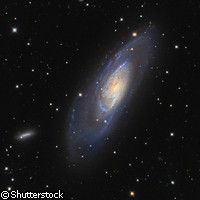Dwarf satellite galaxy researchers say: 'Maybe Newton was wrong'
Two new studies by researchers in Germany, Austria and Australia have brought into question our understanding of the physics behind gravity. The findings, published in the Astrophysical Journal and the Monthly Notices of the Royal Astronomical Society, are based on their examination of dwarf satellite galaxies, or smaller galaxies living 'off the coast' of our large, spiral-shaped Milky Way. Newton's classic theory of gravitation, published in 1687, works well to explain the effects of gravity on Earth, such as an apple falling from a tree. 'Although his theory does, in fact, describe the everyday effects of gravity on Earth, things we can see and measure,' explained Professor Pavel Kroupa of Bonn University's Argelander Institute for Astronomy in Germany, 'it is conceivable that we have completely failed to comprehend the actual physics underlying the force of gravity.' Newton's theory is questioned by many modern cosmologists, whose competing theories of gravitation seek to explain the large number of discrepancies between actual measurements of astronomical phenomena and predictions that are made using theoretical models. The idea that 'dark matter' might be behind these inconsistencies has enjoyed much attention in recent years. However, proof of its existence is incipient. In this latest research, Professor Kroupa and colleagues examined 'satellite dwarf galaxies', which, according to theoretical models, exist in the hundreds around most of the major galaxies, including the Milky Way. Some of these smaller galaxies are thought to contain only a few thousand stars (by comparison, the Milky Way, for instance, is estimated to contain more than 200 billion stars). However, to date, only 30 dwarf satellite galaxies have been observed around the Milky Way. This large discrepancy is commonly attributed to the fact that they have few stars, which makes them too dim to be seen from so far away. But their detailed study has yielded some surprising results. 'First of all, there is something unusual about their distribution,' said Professor Kroupa. 'The satellites should be uniformly arranged around their mother galaxy, but this is not what we found.' The researchers found that all of the Milky Way's 'classical satellites' (the 11 brightest dwarf galaxies) are located on approximately the same plane, forming a kind of disc. They also observed that most of the 11 galaxies rotate in the same direction around the Milky Way, in much the same way as planets revolve around the Sun. The physicists' explanation for these phenomena is that the satellites must have been created through collisions amongst younger galaxies. 'The fragments produced by such an event can form rotating dwarf galaxies,' explained Dr Manuel Metz, also of the Argelander Institute for Astronomy. However, he added, 'theoretical calculations tell us that the satellites created cannot contain any dark matter'. These calculations contradict another of the team's observations. 'The stars in the satellites we have observed are moving much faster than predicted by the Gravitational Law. If classical physics holds, this can only be attributed to the presence of dark matter,' stated Dr Metz. This conundrum indicates that some basic fundamental principles of physics may have so far been incorrectly understood. 'The only solution would be to reject Newton's classical theory of gravitation,' said Professor Kroupa. 'We probably live in a non-Newton universe. If this is true, then our observations could be explained without dark matter.' Until now, Newton's theory of gravitation has been modified only three times: to account for the effects of high velocities (the Special Theory of Relativity), the proximity of large masses (the Theory of General Relativity), and sub-atomic scales (quantum mechanics). Now, the serious inconsistencies revealed in the satellite galaxy data support the idea that in space, a 'modified Newtonian dynamic' (MOND) must be adopted. The MOND theory, first proposed in 1981, modifies Newton's second law of dynamics in order to explain the galaxy rotation problem (the fact that galaxies all rotate at a uniform velocity, which goes against the Newtonian prediction that objects that are 'farther out' will have lower velocities). The new findings have far-reaching implications for fundamental physics and for cosmological theories. According to astrophysicist Bob Sanders of the University of Groningen in the Netherlands, 'The authors of this paper make a strong argument. Their result is entirely consistent with the expectations of modified Newtonian dynamics, but completely opposite to the predictions of the dark matter hypothesis. Rarely is an observational test so definite.'
Countries
Austria, Australia, Germany



